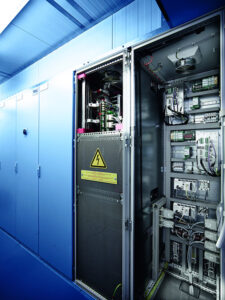How Variable Frequency Drives Work
Frequency Drives Work
The vast majority of industrial motor applications use Variable Frequency Drives (VFDs). In addition to energy savings, VFDs are used for process control, reducing mechanical stress and prolonging AC motor life. The most obvious economic benefit comes from achieving the power that an operator needs for a process, without the wasted energy of running the motor at higher speeds than necessary. This results in significant operating cost savings for the process owner and reduces maintenance expenses as the equipment requires fewer repairs due to less mechanical stress.
A VFD controls the speed of a AC induction motor by varying the frequency and voltage of the output current. Using vector control, the VFD can adjust the frequency and voltage optimally to flow a current required for a given load magnitude.
This allows for a greater degree of energy savings, especially in fan and pump applications where power consumption is proportional to the cube of the velocity. In these applications, lowering the speed by 20% can reduce energy usage by 50%.
Other applications include conveyer belts and conveyors where the VFD can eliminate jerks during startup, increasing production levels, and resulting in higher revenues for the plant. Energy efficiency tax incentives and utility rebates further boost the ROI of VFDs, which also extend equipment lifetimes and significantly reduce maintenance costs.

How Variable Frequency Drives Work
The VFD works by converting the existing alternating current (AC) supply to direct current (DC), then adjusting the voltage. These steps occur in a device called an inverter, which relies on modern power semiconductors that can switch at high voltages and conduct high currents with high efficiency. This technology has only been available at reasonable cost and reliability in the last thirty years or so.
Input current to the inverter is split into two components: the excitation current and the torque current. The VFD then uses vector calculation to identify the load magnitude, based on an encoder measurement of the motor speed. This information is then used to identify the correct input current, which in turn determines the output current.
Once the VFD output current matches the load demand, it is sent out to the drive’s output terminals. There is another set of power semiconductors, called rectifiers, that convert the output current back to AC. These are connected in a bridge configuration to provide six output current “pulses” as the diodes alternately open and close to create the required voltage.
The regenerated DC is fed to a filter on both the line and motor side of the drive. The line side filters stop harmonics from being transmitted out to the load and the motor side filter prevents current reflection inside the drive that could cause overheating or crosstalk. In some cases, additional harmonic mitigation may be needed on the load side of a VFD, such as in installations where there are large reactors on the main line or other large loads that generate high amounts of harmonics. In this case, adding a series of harmonic filters on the line or motor side can be helpful.